

...or to Infrared Photography
|
Infrared Photography with the Olympus E-500 |

|

|
Back to the Olympus E-System...
...or to Infrared Photography |
|
In general, I prefer non-SLR digital cameras for infrared shooting: real-time electronic preview allows for viewing and composing the image without the cumbersome process of taking the IR filter off before each new picture and putting it back on for the actual exposure. Still, there may be reasons for which you will want to use your SLR for this purpose, most critical one is not having another type of a camera at hand. I was a bit afraid that the E-500 may be not too suitable for infrared, as, according to Olympus, it has an improved internal IR-blocking filter, and "improved" suggests less IR transmittivity. This is why my results with the Hoya R72 IR filter were a bit surprising, as the following samples will show. (I haven't used an #87 filter with this camera: it is more restrictive than the R72, so this would be just a waste of time; see the E-300 IR samples.) The samples — October, 2005 I shot these three frames with a brand-new camera in the Horsehead Wetlands Center in Maryland, where a short hike creates a number of opportunities for this kind of pictures. | ||
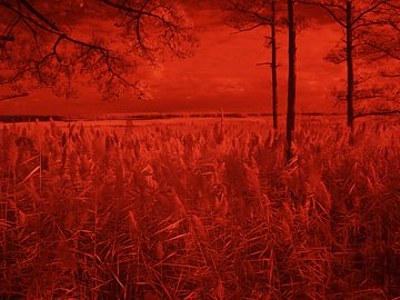
|
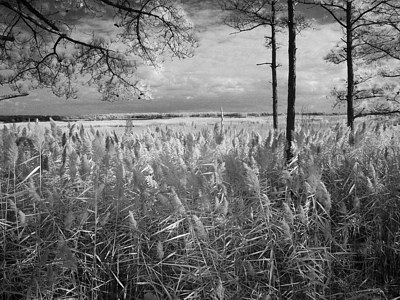
| |
| 14-45 mm lens at 14 mm, program exposure (+1 EV): 1/25 s at F/3.6, ISO 400; WB at 5300K. At left the original JPEG file, reduced and re-sharpened; at right — after desaturation and tonal adjustment. Click here for XGA version. | ||
|
For comparison, here is a reference image of the same scene, taken without a filter, to determine the exposure ratio.
The exposure factor is about 150× or This is quite high response; at ISO 400 infrared images can be taken, if necessary, without tripod. The new anti-IR filter does not seem to affect IR shooting at all. Before taking this result too seriously, however, read on my April shooting session below. |
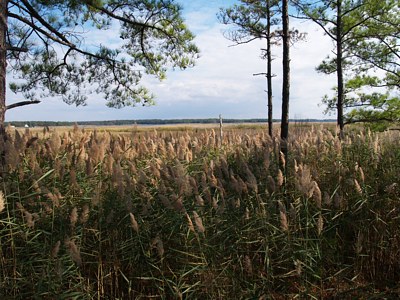
| |
| The same scene as above, shot without the IR filter: 1/400 s at F/11, ISO 400. | ||
|
Two more pictures from the same session, also shot at ISO 400. Only the final results are shown, after desaturation and tonal adjustment. These are not the best you can get, but they should suffice as examples, proving that the E-500 can be used for infrared work, as long as you are willing to live with inconveniences of using an SLR. | ||
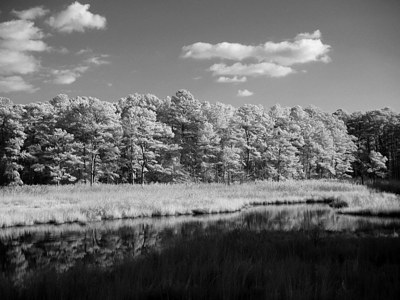
|
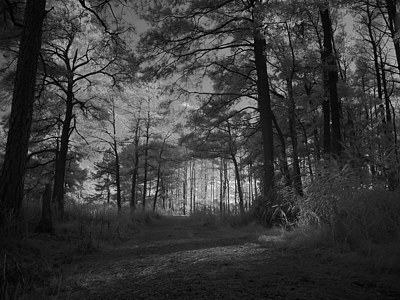
| |
| 14-45 mm lens at 37 mm; program exposure (+1 EV): 0.4 s at F/5.1, ISO 400, WB 5300K. | 14-45 mm lens at 14 mm; program exposure (+1 EV): 0.625 s at F/3.5, ISO 400, WB 5300K. | |
|
The samples of April, 2006 — surprise! Last December the shutter in my E-500 just died; the camera was sent to Olympus for warranty repair, and came back within a week as good as new. This April I took the camera out for another IR spin around my neighborhood. Based on my previous experience, I've set the exposure to auto with a +1 EV compensation — and here a surprise! The fixed E-500 seems to be roughly 10 times less sensitive to infrared than it was before the repair! I had to dial in +5 EV compensation factor, and in many cases (like the frame shown below) more would not hurt, either. Let me show an example picture from that session. | ||
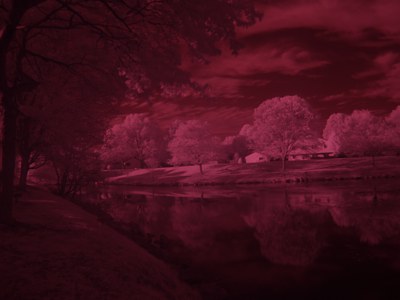
|
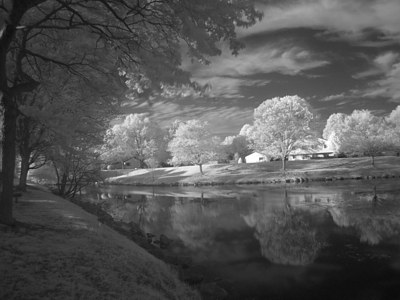
| |
| 14-45 mm lens at 14 mm, aperture priority (+5 EV): 2.5 s at F/3.5, ISO 100; WB at 5300K. At left the resized original; at right — converted to monochrome. Click here for XGA version. | ||
|
The reference image, again, is shown at right. This time the exposure factor is close to 1300×, or 10.3 EV. Compare that to 150× (7.3 EV) recorded before the camera was repaired; this is a significant difference!
Actually, the original IR image above could use up to 1 EV more exposure, but I'm showing it here because my further experiments have shown that +5 EV is a good staring point if you want to depend on exposure automation; besides, the AE compensation in the E-500 extends only to +5 EV, and I was too lazy that day to switch to manual. |
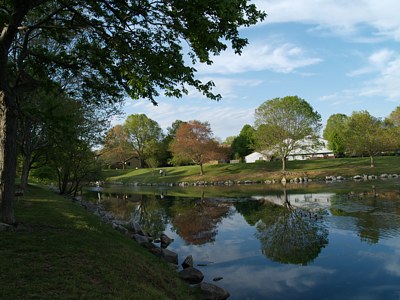
| |
| Without the IR filter: 1/125 s at F/7.1, ISO 100 (aperture priority at -0.3 EV). | ||
|
A few days later I shot a few more IR samples to investigate the matter further. The results leave no doubt: whatever I'm doing (different ISO values, metering patterns, WB settings), the camera is about 10 times less sensitive to infrared than it was before it went to Olympus. Let me spare you the details, and show only one example from the other session, taken from exactly the same spot, about one hour earlier in the afternoon (less IR in the sunlight). | ||
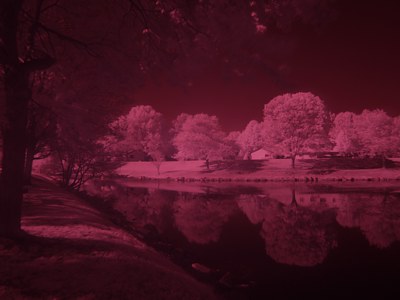
|
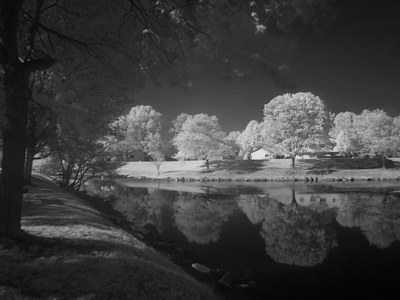
| |
| Same lens, aperture priority (+5 EV, center-weighted): 6 s at F/5.6, ISO 100; WB at 5300K. At left the resized original; at right — desaturated and re-equalized. | ||
|
The +5 EV compensation was adequate that day. By using exposure bracketing, I've also checked +4 and +6 EV; the latter was already excessive: I prefer to have my IR images on the dark side to avoid red channel overload. The reference color image (not shown) needed 1/250s at F/5.6, ISO 100; this is an exposure factor of 1600× (10.6 EV), typical for such a day and consistent with the results obtained a few days earlier. What did Olympus do to the E-500? In addition to the shutter repair, the difference between my camera as of April and October is in the firmware installed: I am now using Version 1.2, while in October I was using the original 1.0. I don't think, however, that the firmware has anything to do with the change in the IR response: the CCD imager receives less or more light regardless of the firmware, and it clearly receives ten times less of it now than before. Also note that the metering system (using independent sensors) continues to provide similar readings as before, within 1 EV. Remember, it was my camera's shutter which went dead. The labor in the U.S. is expensive; it is cheaper to replace the whole assembly which includes the shutter, than to repair it. This assembly, most probably, includes also the anti-IR filter. According to Olympus press releases, this filter was supposed to be "improved" (read: be more restrictive) compared to the E-300, and this, as per my October IR tests, turned not to be the case. Remember also that I bought my E-500 on the very first day of its availability in the U.S. I suspect that the early production runs were still using the "old" anti-IR filter (the same, or similar to that in the E-300), and switched to the "improved" ones later in the process. This explanation would be consistent with all the facts I know. A more restrictive anti-IR filter improves the rendition of colors in visible light. This means that my camera, indeed, was upgraded beyond having the broken shutter fixed. I haven't seen a difference in visible light, but this would really require some strictly-controlled test procedure before and after the changes. What I can only hope for (without any indication to the contrary) is that Olympus knows what they are doing. The E-500 was delivering most pleasing results before the change, and it keeps doing so after; actually, I cannot see any difference due to the new anti-IR filter. Why should you care? The answer is simple. If you are reading this article, this means you are thinking about shooting infrared with an E-500. In this case much will depend on whether the particular camera specimen belongs to the earlier or later batch. The earlier batches have IR sensitivity about ten times higher than the later ones, and this is regardless on whether my explanation of the underlying reasons is true or not. Therefore the answer how suitable the E-500 may be for infrared photography will depend on how recently was the particular camera manufactured. Of course, the switch may also invalidate some of the published tests of visible-light image quality, based on early production runs. I'm not a believer in those tests anyway. What I dislike, though, is that the whole operation was performed without a single warning or announcement. This is too major a change to be made in secret. You may, of course, set the manual exposure by trial and error, starting from the values shown in examples above. You may also use the camera's metering, but you have to determine which version of the E-500 you have.
Remember that a properly-exposed IR image should look dark, otherwise the red-only highlights will be blown out; check, again, my general IR article for more on this. If in doubt, have a look at the red-component histogram after the picture has been taken (this is a life-saving feature in the E-500). At ISO 400 my infrared images show considerable noise. If you are bothered by this, switch to ISO 100; even with the longer exposures necessary, the noise will be significantly lower. With the improved low-light autofocusing capability of the E-500, letting the camera focus through the filter is usually, if not always, safe, especially for wider-aperture lenses (regardless of what aperture is actually used). This may be better than focusing manually or using the AF before putting the filter on, and then switching to manual to retain the setting: the focus shift between visible and infrared light might be a problem. Stepping the lens down to F/8 may be recommended if you are not sure about the focusing accuracy. The E-500, according to Olympus, can autofocus down to EV 0 with an F/2 lens at ISO 100, which means a four-second exposure at that aperture. More, it can be shown that the four-second, full-aperture exposure at ISO 100 is a limit for any lens. For example, with an F/4 lens the AF sensor receives 2 EV less light, thus the AF will work from EV 2. An EV 2 exposure at F/4 is, again, four seconds. Note that if AF works for a four-second exposure at full aperture, it will work equally well for appropriately longer ones with the lens stepped down. For example, with an F/2.8 lens, the AF should be fine up to 16 s at F/5.6 or 30 s at F/8; this is because autofocusing is done with the lens fully open! Now, a typical sunny-day IR exposure with a "new" E-500 is about three seconds at F/4 or six seconds at F/5.6. This is just inside the "official" AF sensitivity range if you are using the 14-45 mm F/3.5-5.6 ZD lens at the wide end, and just outside that range at the long end. Living dangerously. Switching to the 14-54 mm F/2.8-3.5 ZD lens will certainly help. The AF sensors at the bottom of the mirror chamber (unaffected by the changed anti-IR filter) see the same amount of light regardless of the differences between "old" and "new" runs. This leads me to believe that the AF is not affected by the filter change. Here the E-500 has, again, a winning feature you will not find in competing models: focus bracketing. Let the term "manual focus" (used by Olympus here) not deter you: this can be set up so that the camera will autofocus on demand when you press of the [Lock] button while in the manual focus mode; see another article on this subject. This can be, actually, the safest way to do focusing in infrared with the E-500. | ||

|

|
Back to the Olympus E-System...
...or to Infrared Photography |
| Home: wrotniak.net | Search this site | Change font size |
| Posted 2005/10/31; last updated 2008/03/16 | Copyright © 2005-2008 by J. Andrzej Wrotniak |